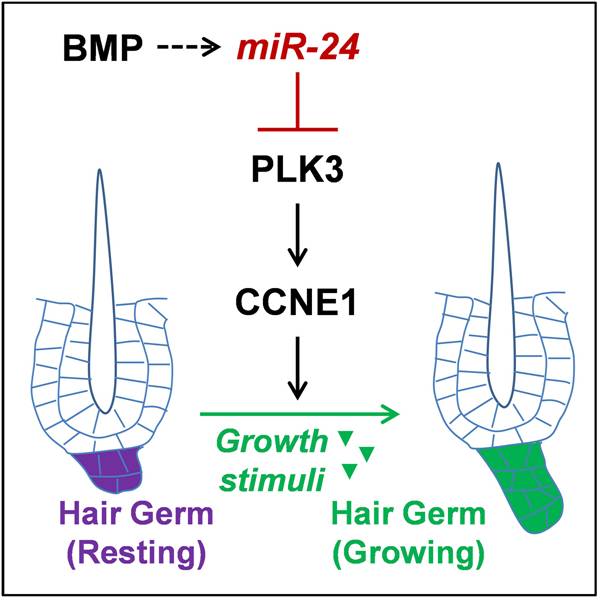Researchers Uncover New Regulatory Mechanism for Skin Hair Regeneration Capacity
On June 8, 2021, Cell Reports published online the research results of “miR-24 controls the regenerative competence of hair follicle progenitors by targeting Plk3” by Prof. ZHANG Liang's group from the Shanghai Institute of Nutrition and Health (SINH), of the Chinese Academy of Sciences. This study revealed the role and mechanism of miR-24 in limiting the regenerative competence of hair follicle (HF) progenitors, enlightening a new potential therapeutic avenue for treating hair loss.
Alopecia or hair loss is one of the most common human conditions in the world. Statistics from the National Health Commission of China showed that the number of Chinese people with alopecia was rising sharply in recent years and had exceeded 250 million. However, effective treatment for this disease is still lacking.
How adult stem cells (SCs) respond appropriately to environmental stimuli is a question of fundamental importance in SC biology. In the skin, activation of hair follicle stem cells (HFSCs) and progenitors by growth factor stimulation is the basis for HF and hair regeneration. On the other hand, hair regeneration defects can often attribute to blunted responses of HFs to growth stimuli. However, it is still not well understood how the sensitivity of HFSCs or progenitors to growth stimuli is determined. Elucidating this question will provide important clues for the treatment of hair-related diseases such as alopecia.
The researchers found that the resting-to-activation transition of HF is associated with significant down-regulation of a microRNA, miR-24, in HF progenitors prior to their activation. By constructing and analyzing mouse models of skin epithelium specific miR-24 inducible over-expression or conditional ablation, the researchers found that miR-24 acts to limit the sensitivity of HF progenitors to growth stimuli. miR-24 over-expression in the skin epithelium significantly delayed HF progenitor activation and hair cycle progression, while its conditional ablation significantly accelerated hair cycle and sharpened the HFs' sensitivity to growth stimuli.
It is worth noting that the conditional ablation of miR-24 in skin epithelium significantly improved the effect of Minoxidil lotion on stimulating hair growths without discernible side effects, indicating miR-24 as a new potential target for hair regeneration therapies. Mechanistically, the researchers discovered that Plk3 is a new miR-24 target gene that mediates the function of miR-24 to limit hair growth by regulating CCNE1, a key cell cycle regulator. In addition, the researchers also found that miR-24 acts downstream BMP, which is a known inhibitory signal for hair growth.
The study revealed that miR-24 is a key factor limiting the regenerative competence of skin HF progenitors, and enlightened a new avenue for treating hair regeneration-related diseases such as alopecia.
Dr. LIU Fengzhen from SINH is the first author of the article, and Professor ZHANG Liang is the corresponding author of this article. This study was supported by funding from Ministry of Science and Technology of the People's Republic of China, the Chinese Academy of Sciences, the National Natural Science Foundation of China, and the Science and Technology Commission of Shanghai Municipality. It also received kindly help from Dr. QIn Jun at SINH and Dr. CHEN Ting at the National Institute of Biological Sciences.

Proposed model of miR-24 limiting the regenerative competence of HF progenitors.
(Image by Prof. ZHANG Liang's group)
Media Contact:
WANG Jin (Ms.)
Shanghai Institute of Nutrition and Health,
Chinese Academy of Sciences
Email: sibssc@sibs.ac.cn
Web: http://english.sinh.cas.cn/
